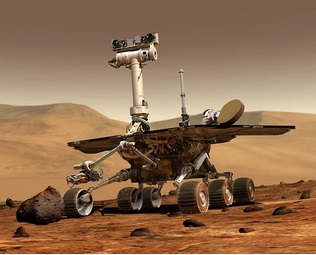After the first images sent in recent days, the Chinese rover Zhurong safely descended from the lander platform and touched down on the surface of Mars this morning at 10:40 in Beijing (4:40 in Italy), kicking off exploration and leaving its first “footprints” on the Red Planet, the China National Space Administration (Cnsa) reported.
Zhurong’s arrival made China the second country after the United States to have a rover operational on Mars: with its six solar-powered wheels, resembling a blue butterfly and with a mass of 240 kg, the small vehicle slowly descended from a ramp towards the sandy Martian soil.
China’s Tianwen-1 mission, consisting of an orbiter, a lander and a rover, was launched on 23 July 2020. The lander carrying the rover landed in the southern part of Utopia Planitia, a vast plain in the northern hemisphere of Mars, on 15 May. The Zhurong rover is named after the ‘God of Fire’ in ancient Chinese mythology, which echoes that of Mars, also in Mandarin of . Huoxing (the planet of fire).
Zhurong will record the Martian landscape with high-resolution three-dimensional images, analyse the material composition of the planet’s surface, and detect its subsurface and magnetic structure. It will look for traces of water ice and observe the surrounding meteorological environment.
The rover carries various scientific instruments, including a surface and multispectral camera, subsurface exploration radar, surface composition detector, magnetic field detector and meteorological monitor.
The orbiter, with a design life of one Martian year (approximately 687 days on Earth), will transmit communications for the rover while conducting its own scientific survey operations.
Pechino, rover Zhurong lascia piattaforma: inizia esplorazione
Dopo le prime immagini inviate nei giorni scorsi, il rover cinese Zhurong è sceso in sicurezza dalla piattaforma del lander e ha toccato la superficie di Marte questa mattina alle 10:40 di Pechino (le 4:40 in Italia), dando il via alla esplorazione e lasciando le sue prime “impronte” sul Pianeta Rosso, ha riferito la China National Space Administration (Cnsa).
La missione cinese Tianwen-1, composta da un orbiter, un lander e un rover, è stata lanciata il 23 luglio 2020. Il lander che trasportava il rover è atterrato nella parte meridionale dell’Utopia Planitia, vasta pianura nell’emisfero settentrionale di Marte, il 15 maggio. Il rover Zhurong prende il nome dal “Dio del fuoco” nella antica mitologia cinese che riecheggia quello di Marte, sempre in mandarino di Huoxing (il pianeta del fuoco).
L’arrivo di Zhurong ha reso della Cina il secondo Paese dopo gli Stati Uniti ad aver reso operativo un rover su Marte: con le sue sei ruote a energia solare, simile a una farfalla blu e con una massa di 240 kg, il piccolo mezzo è sceso lentamente da una rampa verso il suolo sabbioso marziano.
Zhurong registrerà il paesaggio marziano con immagini tridimensionali ad alta risoluzione, analizzerà la composizione materiale della superficie del pianeta, rileverà la sua struttura sub-superficiale e magnetica. Cercherà tracce di ghiaccio d’acqua e osserverà l’ambiente meteorologico circostante.
Il rover trasporta vari strumenti scientifici, tra cui telecamera di superficie e multispettrale, radar di esplorazione sub-superficiale, rilevatore di composizione della superficie, rilevatore di campo magnetico e monitor meteorologico.
L’orbiter, con una vita di progetto di un anno marziano (circa 687 giorni sulla Terra), trasmetterà le comunicazioni per il rover conducendo allo stesso tempo le proprie operazioni di rilevamento scientifico






